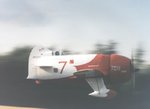Arsenal VG-33
Senior Airman
What was the first fighter to include a 20mm?
The Dewoitine D.510?
I'm not sure at the moment what was the first mass produced fighter armed with a 20mm cannon, but the cannon made it's appearance mounted on French bombers during WW 1, either a 37mm or 47mm (37mm being much more common) used mostly against ground targets. I believe it was 1915 (?), it was mounted on a Voisin 4 or 5, and also a few on Breguets BR.Ms. They were forward firing, on a swivel mount with a gunner, with the pilot sitting behind.
On the subject of 1935ish, I'd like to point out that the Morane MS. 405 first appeared in 1935, and in 1937 was voted the best fighter plane in the world after performing at the Brussel Air Ahow. After a few modifications, the MS-406 was put into mass production. The export versions were much better, doing away with the overly complicated radiator mechanisms of the domestic models.



